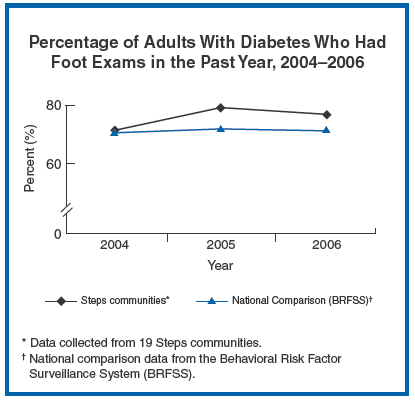|
|
|||||||||||||
|
|
|
|
|
||||||||||
|
|

|
|
|
|
Steps Program
| ||||||||||||||||||||||||||||||||||||||||||||||||||||||||||||||||||||||||||||||||
Today, chronic diseases account for 7 in 10 deaths and affect the
quality of life of 90 million Americans. Diseases such as obesity,
diabetes, and asthma are some of the leading causes of death,
disability, and rising health care costs in the United States. The
significant rise in chronic disease rates among adults and young people
is a concern across the country, including in communities, schools, and
work sites and
among families, health care providers, and policy makers. The following
data indicate the extent of this burden:
For example:
Exercising regularly, eating a healthy diet, and avoiding tobacco use and exposure can help people prevent and manage chronic diseases. However, many people in the United States do not have easy access to healthy foods and safe, convenient places to exercise. These barriers have led to increasingly unhealthy and sedentary lifestyles for the majority of Americans. Concentrated efforts are needed in local communities across the country to confront the national epidemic of chronic diseases.
CDC is committed to ensuring that all people, especially those at greater risk for health disparities, achieve their optimal lifespan with the best possible quality of health in every stage of life. With agency-wide health protection goals that support healthy people in healthy places across all life stages, CDC is setting the agenda to enable people to enjoy a healthy life by delaying death and the onset of illness and disability by accelerating improvements in public health.
One important way that CDC is responding to the country’s rising chronic disease burden is by accelerating change at the local level. To support this goal, the Steps Program funds communities across the country to show how local initiatives can reduce the burden of obesity and other chronic diseases and to encourage people to be more physically active, eat a healthy diet, and not use tobacco. The Steps Program is accelerating change at the local level by

Steps communities document progress toward key health outcomes by participating in the Behavioral Risk Factor Surveillance System (BRFSS) and the Youth Risk Behavior Surveillance System. Data from selected communities funded in 2003 indicate that

[A text description of this chart is also available.]
The Steps Program is using the following key principles and strategies to create and sustain change at local levels across the country.
Real community involvement is needed to successfully change policies and environments and prevent chronic diseases at the local level. In each community, the Steps Program brings together a diverse group of leaders from the public sector, nonprofit organizations, and private entities to design unique disease prevention and health promotion strategies that respond to local needs and take advantage of local assets.
Steps communities partner with members of groups that are most at risk for chronic diseases, including rural residents, racial and ethnic minority groups, and poor and underserved populations. Creating Nontraditional Partnerships Steps communities are reaching out to people in nonhealth sectors—such as transportation, chambers of commerce, the media, and cooperative extension services—to increase their participation in local chronic disease prevention programs. These partnerships help pool resources to more effectively confront the burden of chronic disease in local communities.
The Steps Program collaborates with partners in many different areas where actions are needed to promote health. Examples include schools, work sites, health care settings, and faith-based settings. These partnerships are helping institutions make the kinds of decisions that will be required at the local level to prevent the rising rates of chronic disease.
Steps communities are charged not only with addressing a wide range of health challenges, but also with doing so across the entire life span. This multigenerational approach is providing millions of people with integrated and urgently needed activities and programs designed to prevent chronic diseases.
Steps communities collaborate with local, regional, and national groups to ensure that their programs are sustainable. Partners are often encouraged to take ownership of projects within local Steps programs and to integrate those activities into existing operations. Partnerships with organizations such as the YMCA of the USA and state health departments are expanding the impact of the Steps Program.
The Steps Program in the River Region of Alabama trained diabetes wellness advocates to help people with diabetes set health and wellness goals and manage their condition. As a result of this program, emergency room visits among participants decreased more than 50% during 2004–2007.
The Steps Program in Austin, Texas, established a work-site wellness program with Capital Metro, the Austin transit authority. Employees received customized health assessments and action plans for creating healthier lifestyles. As a result of this program, employee absences dropped more than 44% during 2004–2006. Annual health care costs increased by only 9% during 2004–2005, compared with 27% during 2003–2004. The use of “healthy choice” options in the employee cafeteria increased 172%.
In Broome County, New York, the Steps Program has reached families in rural areas by implementing an innovative walking program that has enrolled more than 50,000 people in 4 years. The proportion of adults who walk for more than 30 minutes on 5 or more days each week increased from 47% to nearly 54% in 1 year. Broome County’s Steps Program also has improved the food offered in local schools. Fifteen school districts worked together to buy healthy foods at lower cost so schools could afford them. As a result, fresh fruits and vegetable consumption has increased 14% in participating schools. The Steps Program also expanded the county’s nationally recognized Mission Meltaway program to reach more than 2,500 people; more than half of the participants in this program lost weight.
The Steps Program in Pinellas County, Florida, implemented a program in K–12 schools to increase fruit and vegetable consumption among students and staff members. Lunch lines were revamped to display prepackaged salads that are easy for children to open and eat; school administrators, cafeteria managers, and food service employees received training in the importance of healthy eating and proper food preparation; and a local vegetable distributor set up farmers’ markets on school grounds.
As a result, more than 3,700 students and staff members increased their fruit and vegetable intake, and 84% of schools and 90% of their students and staff are participating in the farmers’ markets. In August 2007, the Pinellas County School District was rated first in the nation among large school districts on the Physicians Committee for Responsible Medicine’s School Lunch Report Card.
The Steps Program of the Cherokee Nation in Oklahoma made
important changes to the school environment in all 19 schools with
predominantly American Indian students. These changes include developing
wellness policies, offering healthier choices in vending machines and
cafeterias, and providing access to exercise facilities after school. Nine
schools developed and implemented 24/7 tobacco-free school policies. In
Michigan, the Anishinaabe Steps Program and the Inter-Tribal Council
of Michigan have undertaken groundbreaking work to collect data in American
Indian communities. They used BRFSS surveys to provide baseline data on how
much residents know about disease prevention. The data will be used to
design and deliver more effective programs to promote
health and prevent disease in American Indian communities.
In collaboration with the Steps Program in Chautauqua County, New York, a local hospital changed its policy on asking patients about tobacco use and implemented a 2-minute tobacco cessation intervention that has been shown to be effective in helping smokers quit. More than 547 health care providers were trained on the intervention, and the hospital changed its patient intake and education forms to reflect the new process. As a result of the new policy, total calls to the New York State Smokers’ Quitline from health care provider referrals increased four-fold during 2005–2006. In addition, county data show a decrease in smoking rates in Chautauqua County, from nearly 29% in 2004 to less than 24% in 2006.
CDC’s Steps Program will continue to work with various institutions and organizations to create a tipping point toward better health for all Americans by supporting communities that show what can be done at the local level to prevent chronic diseases.
|
Page last reviewed: March 24, 2008
Page last modified: March 24, 2008
Content source: National Center for
Chronic Disease Prevention and Health Promotion
|
|
|
||||||||||||
|